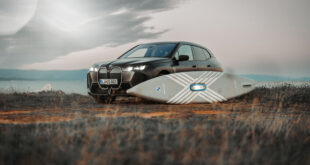 Here is an excerpt of the BMW i8 review by The Irish Times:
Here is an excerpt of the BMW i8 review by The Irish Times:
And it’s quick. Very quick. When both the motors are punching hard, so does the i8. It’s maybe not 911 quick over the first 20 metres, but it seems like it covers ground on the legendary rival after that. And at higher speeds, above 150km/h, the slippery shape helps the i8 accelerate like it’s not fading away at all.
Then there’s the handling. All that low weight means it’s a slingshot jet in faster corners, stretching the bounds of credulity as it flits between high-speed sweepers and bends. It’s delightful, even if the accurate steering could use some feedback instead of feeling a bit like a gaming console.If it’s tackling the road in third gear or higher, it has brilliant throttle response, with the electric motor arriving first (just) and the rear motor helping an instant later. Its flat cornering helps, too, and the rear end never feels like it will bite, even over the bumpiest roads with the most ham-fisted moves. It’s excellent stuff when the pressure is on over fast roads, which makes the low-speed quirks so damned irksome.
If the i8 is attacking bends in second gear (or having to downshift to second regularly), it’s nothing like as convincing a machine as it is when the going is faster.
Initially, that’s because the damned gearbox is inconsistent on its downshifts. It’s probably the cheapest part of the car and feels it. There were times when it wouldn’t respond to the downshift paddle, even though it was labouring the engine at 3000rpm, then at other times it would merrily downshift at 4500rpm to get to the same (second) gear.
It also doesn’t have a proper manual mode, with the car auto upshifting at the limiter and maintaining a détente kickdown, regardless of how obviously you were tapping paddles.
Then there’s the initial turn in. Its front tyres are like toothpicks compared to the rest of the sports car world (195/50 R20) and they’re also geared up for efficiency. And, if you arrive at a corner from a straight piece of road and try tipping it in at anything like a normal 911 pace, you’ll find yourself battling significant understeer while the rubber squeals constantly.
It’s odd, because the car will change direction impressively if there is any lateral load on the suspension, like going from one corner to another, but it’s singularly unimpressive moving from a straight line.Coupled to that is an overly busy-body ESP (the car is way better when you switch it off and the chassis is so calmly organised that the i8 won’t bite) and very lazy response when you’ve finally got the nose turned in to a corner and you try to pick up the throttle.
And when the drive does come in, it feels like the delay has been caused by the electric motor up front waiting for the ICE delivery to reach its levels. And then the car gets torque steer from the electric motor on the way out. And there doesn’t feel like there is any torque vectoring at all, which is one of the supposed benefits of electric performance cars.
To be fair on the i8, it has been a rushed and incredibly complex development period and there is still more to come from the software – and most of our issues felt software related (gearbox apart). But it’s still nothing like as intuitive to drive across the board as a 911, even though it’s a diamond in faster bends.
 BMW.SG | BMW Singapore Owners Community The Ultimate BMW Community – Established Since 2001
BMW.SG | BMW Singapore Owners Community The Ultimate BMW Community – Established Since 2001













